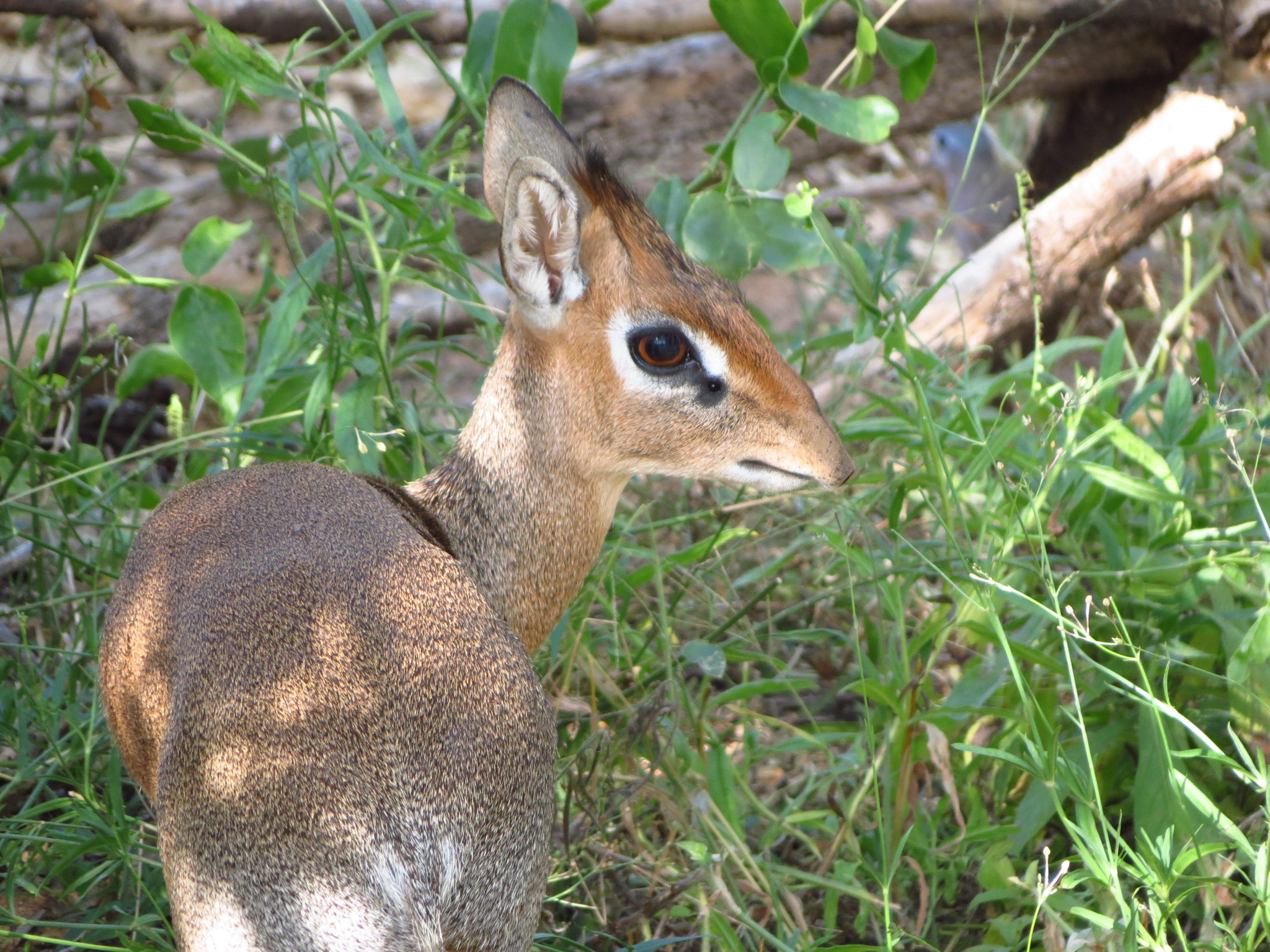- Home
- Conservancy
- Kirk's Dik Dik
Description
The Kirk's dik-dik (Madoqua kirkii) is a small antelope native to Eastern Africa and one of four species of dik-dik antelope. It is believed to have six subspecies and possibly a seventh existing in southwest Africa. Dik-diks are herbivores, typically of a fawn color that aids in camouflaging themselves in savannah habitats. According to MacDonald (1985), they are also capable of reaching speeds of up to 42 kilometers per hour.The lifespan of Kirk's dik-dik in the wild is typically 5 years, but may surpass 10 years.In captivity males have been known to live up to 16.5 years, while females have lived up to 18.4 years.
Physical Characteristics
"Dik-diks are some of the world's smallest antelopes, with the largest, the Kirk's dik-dik, standing between 14 and 18 inches tall and weighing no more than 7.2 kg (16 lb). Female dik-diks tend to be 1 to 2 pounds heavier than males. Dik-diks are dainty creatures with a pointed, mobile snout, large eyes and ears, prominent preorbital glands, pipestem legs, hare-like hind limbs that are significantly larger than their forelimbs, and a vestigial tail.Their coats, depending upon their habitat,range from grey to gray-brown with tan flanks, limbs, and an erectile head crest and whitish eye rings, ear lining, underparts, and rump".
Only male dik-diks sport horns, which are approximately 3 inches long, corrugated, and backward-slanted.Horns of male Kirk's dik-dik may be straight or curved backwards from the profile of the face and the basal half of the horns have seven to nine annular ridges, that are frequently covered by the crest.Kirk's dik-dik are sexually dimorphic: females are larger and lack horns, while males sport a more developed muzzle, a longer crest, and tend to be lighter in color.Though physically very similar the Kirk's dik-dik can be distinguished from Guenthers’ dik-dik due to its longer nasals and premaxillae and shorter proboscis, which gives the head a more wedged-shaped profile than that of Guenther's dik-dik.
Adaptations
Kirk's dik-diks are highly adapted to surviving in the arid regions of eastern Africa. They have a hairy proboscis with tiny slit-like nostrils, a feature that is most pronounced in the Guenther's dik-dik.This proboscis contains an enlarged nasal chamber that is supplied with a rich amount of blood that is cooled via rapid nasal panting.Panting through their snouts leads to airflow and evaporation that cools the blood before it is pumped back into the body.2 This process is also efficient, because it results in a minimal loss of water in the exhaled air. Water and energy conserving methods, such as fluctuating body temperatures, lowered metabolic rates, concentrated urine, and dry feces all contribute to the ability of the dik-dik to survive harsh arid climates.Further, as observed by Hoppe 1977b, Kamau 1988, and Maloiy et al., 1988, they also conserve fluids by licking dew from their nose and reabsorbing water from their feces.When compared to cattle, dik-dik have a significantly lower density of sweat glands.
Behaviorally, dik-diks are highly nocturnal and during the daytime seek shade to rest throughout the hottest parts of the day to help avoid the loss of valuable fluids.Dik-diks are also highly selective when browsing on succulents, herbs, and foliage as to maximize fluid acquisition.The hind legs of the Kirk's dik-dik are longer and are structurally more uniform, than the forelegs. Hopwood 1936 suggests that, this helps the hind legs propel the dik-dik forward, as the relatively short forelegs of dik-diks are more efficient at ascending broken terrain
Fun Facts
Reproduction And Behavior
Similar to other dwarf antelopes, Kirk's dik-diks exist in monogamous pairs on territories. Territories are marked with dung and urine that are deposited in a ritual that is performed to help helps maintain pair bonds. During the ritual, the female will excrete, followed by the male, which samples the female's urine stream to check her reproductive capacity. He paws over and then marks his dung and urine over her deposit. Finally, the pair marks nearby twigs with secretions from their pre-orbital glands. Kingon 1982 states that, "The male courts the female by running up behind her with his head and neck stretched and his muzzle pointing out in front. Copulation begins with the male standing on his hind legs behind the female and waving his forelegs at an acute angle to his own body in the air over her back".[4] Copulation typically occurs anywhere between three and five times within a 9-hour period.
Kirk's dik-dik have a gestation period of 5–6 months, and may produce up to two offspring per year. Females reach sexual maturity between 6 and 8 months of age, while this occurs for males between 8 and 9 months.Dik-dik produce one offspring per gestation. Most births occur between November and December and April through May, which coincides with the timing of the rainy seasons. Dik-diks differ from other ruminants in that offspring are born with their forelegs along the body, rather than extended forward."After birth, the offspring lie concealed away from their mother 2-3 weeks and survival rates for fawns are roughly around fifty percent.Once offspring reach a certain age, they also begin to participate in the bonding ritual, and will remain with the parents until another offspring is born. At this point, the parents will chase the older sibling out of their territory.The older offspring then seeks out its own territory and mate.





